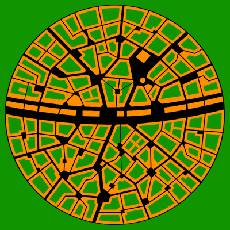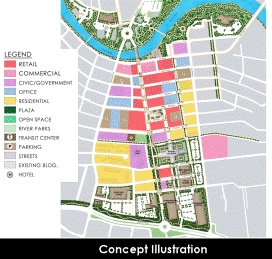This post continues Neighborhood design: a Sesame Street-based analysis (Part 2) (which continues Part 1).
*** *** ***
 Why would people be walking among their neighbors in the first place? I want to suggest a few reasons and to look at the conditions that would make those reasons possible. Keep in mind that one reason alone, if it generates enough foot traffic, is sufficient — though obviously there would be a combination of all types of uses, where they were possible.
Why would people be walking among their neighbors in the first place? I want to suggest a few reasons and to look at the conditions that would make those reasons possible. Keep in mind that one reason alone, if it generates enough foot traffic, is sufficient — though obviously there would be a combination of all types of uses, where they were possible.
For exercise. As for all purposes, this requires some safety for pedestrians. Neighborhood safety is a huge topic of its own, so for here I’ll just say: Pedestrians (or bicyclists, or joggers) should feel safe from cars; the built environment should be safe (e.g., few potholes); the streets should be well lit; and there should be enough eyes on the street to provide community “policing” (since fewer violent crimes will be committed under the watchful eyes of neighbors). Also, the neighborhood must be a generally pleasant enough — welcoming spaces, structures or activities worth looking at, no industrial noise or pollution — that people don’t give up on the neighborhood and choose someplace else for their exercise walk.
However, if you’re going out strictly for exercise, it may be difficult to meet people on the street “each day,” since you probably want to stay moving to keep that heart rate up. For this reason, even though I like many of the required neighborhood conditions, I give “for exercise” a low priority.
(That said, if you’re out walking in your neighborhood on a daily basis, you’re likely to be getting more exercise already than if you drive your car to the same destinations.)
For pleasure. Here I include walks taken for people-watching, for bird-watching, for enjoying the scenery, for taking in smells and sounds, and all other aesthetic, non-goal-driven reasons.
This steps up the requirements for neighborhood safety and beauty: while people may tolerate some ugliness or minor dangers while in pursuit of fitness, pleasure-walkers will put up with less, since the whole goal is to have an enjoyable walk. An uninviting neighborhood — whether it is dangerous, ugly, or just plain boring — will encourage people to take their strolls elsewhere. Indeed, the absence of pleasurable walks in a neighborhood will encourage people to reside elsewhere, perhaps somewhere far from neighborhoods. Witness the number of people who live on the periphery of Fairbanks in isolated, woodland settings. When so many of our city neighborhoods are monotonous (and some dangerous), who can blame them?
The question of what is pleasurable to people taking a stroll — what scenery, what activities, what smells and sounds — is partly subjective and would require more time to write about than I have available. But certain things are so universally despised or feared that we can safely say they would take the pleasure out of a walk: waste and refuse sites, prisons, and the smoke and noise of heavy industry, for example.
However, to suppose that most people have time for pleasure walks most days is preposterous. While this activity should be supported in a neighborhood, it can hardly be expected to generate much pedestrian traffic by itself.
For visiting. Perhaps it is the bias of a parent with small children, but I have a hard time imagining myself visiting a friend’s home every day, or even most days. Among my friends, home visiting is not too frequent — maybe as often as once a week — and something like a special occasion.
But suppose that it’s not a special occasion for most people, that “the people in your neighborhood” do make social calls on friends or relatives roughly every day. That means that every person who goes visiting has either (a) one very important person whom he or she sees every day, or (b) a great concentration in the neighborhood of many friends or acquaintances.
I think it’s unlikely that most people have one special person — whether a paramour, an ailing relative, or a best friend — whom they visit on a daily basis. Some, yes, but not most. If visits to your friends’ homes are an everyday occurrence, then you probably have a significant number of friends in your neighborhood. That implies a high population concentration, unless you live in an “intentional community” that consists solely of people you like.
For business. “Business” doesn’t mean just making money; it can be just about anything. It includes all kinds of establishments for the products and services that an average person might need on an average day: grocery stores, barbershops and salons, hardware stores, clothiers, bicycle repair shops, music stores, electronics stores, attorneys, doctors, counselors, pharmacies, cafés, restaurants, churches, office supply stores, sporting goods stores, news stands, branch libraries, bookstores, and schools.
Some of these goods and services are needed more routinely than others: Certainly we can imagine needing groceries frequently, and people hit cafés and restaurants plenty often when they’re close. Most kids go to school five days a week. As for the other destinations, they may not be everyday for everybody, but among a large enough population they have a steady supply of daily visitors — and most people, on a near-daily basis, will use at least one.
What is required for this is that the businesses also be within walking distance of people’s homes — say, five minutes, or ten on the outside. (Again, how far are you willing to walk regularly when it’s twenty below?) Under current ordinance in most places, this is effectively illegal: areas of town are “zoned” into residential, civic, and commercial. With rare exceptions, the uses may not mix, which means that most people cannot walk (except at impractical length) to get a haircut, check out a book, or even buy a roll of toilet paper.
For people to be able to go about their business on foot, neighborhoods need what is called mixed-use zoning: all commercial and civic uses that are compatible with neighborhood living (this rules out heavy industry) are allowed to mix in the same neighborhoods, on the same blocks, and even in the same buildings as people’s homes. Ideally, the uses that generate the greatest pedestrian traffic — retail, mostly, with some high-use commercial and civic, like bank and library branches — are located at street level, making the street an attractive place to be.
What’s more, businesses must be within walking distances not only of some homes, but of enough homes to support those businesses financially without attracting too much automobile traffic — since traffic will intimidate pedestrians and diminish the public sphere. If businesses’ customers come from too far away, then “the people that you meet each day” may never be the same from day to day, and knowing your neighbors becomes more difficult.
This seems like the surest way of ensuring regular foot traffic, where people may meet their neighbors “each day.” Not everyone takes regular walks for exercise, visiting, or pleasure. But everyone runs errands; everyone has business to do. The surest way to bring neighbors together often is to bring that business into the neighborhood.
***
So, to summarize:
- If you have a neighborhood, you have neighbors. There may be an upper limit to the number, but there is certainly a lower limit. “Critical mass” is important.
- To run into each other regularly, neighbors must live within walking distance either of each other or of the places they frequent. This means that the neighborhood is small: walking distance from center to edge.
- All kinds of land uses, especially the high-traffic commercial and civic, should be encouraged to mix with the residential, and not be zoned separately, outside of walking distance.
- Residences should be planned densely enough to support neighborhood businesses. This means that very few buildings in an ideal neighborhood, if any, should be zoned “single-family residential”. Property lots should be small.
***
Am I really saying that Sesame Street was this deep? that the Children’s Television Workshop had a civic agenda that included neighborhood planning? that Bob and the Muppets were trying to convey something about zoning ordinances and desirable population densities?
Of course not.
Sesame Street has never dealt in Deep Thinking or in Great Truths. Nor has it worked by guile. It has always dealt in plain and obvious truths — things like, “You should help friends in need,” or “Garbage makes the streets ugly,” or “Don’t talk too loud at the movies.”
I think that this is the strength of appealing to Sesame Street for a model of ideal neighborhoods: their definition of “the people in your neighborhood” is so simple and so obvious that nearly every adult hearing it would nod along, saying, “Sure, of course that’s what neighborhoods are like.” It appeals to the mental models so many of us have of authentic neighborhood life.
So, enjoy your neighbors. I wish you luck in meeting them as you walk down the street each day.
Read Full Post »
 “Eighty percent of success is showing up.” –Woody Allen
“Eighty percent of success is showing up.” –Woody Allen Why would people be walking among their neighbors in the first place? I want to suggest a few reasons and to look at the conditions that would make those reasons possible. Keep in mind that one reason alone, if it generates enough foot traffic, is sufficient — though obviously there would be a combination of all types of uses, where they were possible.
Why would people be walking among their neighbors in the first place? I want to suggest a few reasons and to look at the conditions that would make those reasons possible. Keep in mind that one reason alone, if it generates enough foot traffic, is sufficient — though obviously there would be a combination of all types of uses, where they were possible.